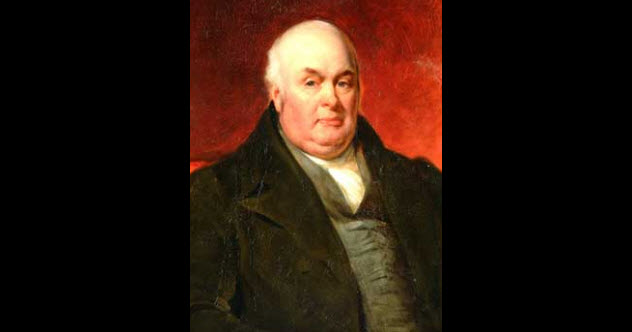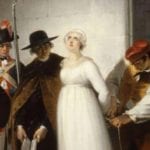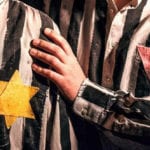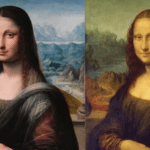 Mysteries
Mysteries  Mysteries
Mysteries  History
History 10 Surprising Stories About the Texas Rangers
 Humans
Humans 10 Philosophers Who Were Driven Mad by Their Own Theories
 Miscellaneous
Miscellaneous 10 Video-Game-Worthy Weapons and Armors from History
 Weird Stuff
Weird Stuff 10 Psychics Who Accurately Predicted Wartime Events
 The Arts
The Arts 10 Pieces of Art Inspired by a Broken Heart
 Health
Health 10 Science Fiction-Sounding New Medical Treatments
 History
History 10 Surprising Facts About the Father of Submarine Warfare
 Space
Space Ten Astonishing New Insights into Alien Worlds
 Weird Stuff
Weird Stuff 10 Bizarre Summer Solstice Rituals Still Practiced Today
 Mysteries
Mysteries Top 10 Haunting Facts About the Ghost Ship MV Alta
 History
History 10 Surprising Stories About the Texas Rangers
 Humans
Humans 10 Philosophers Who Were Driven Mad by Their Own Theories
Who's Behind Listverse?

Jamie Frater
Head Editor
Jamie founded Listverse due to an insatiable desire to share fascinating, obscure, and bizarre facts. He has been a guest speaker on numerous national radio and television stations and is a five time published author.
More About Us Miscellaneous
Miscellaneous 10 Video-Game-Worthy Weapons and Armors from History
 Weird Stuff
Weird Stuff 10 Psychics Who Accurately Predicted Wartime Events
 The Arts
The Arts 10 Pieces of Art Inspired by a Broken Heart
 Health
Health 10 Science Fiction-Sounding New Medical Treatments
 History
History 10 Surprising Facts About the Father of Submarine Warfare
 Space
Space Ten Astonishing New Insights into Alien Worlds
 Weird Stuff
Weird Stuff 10 Bizarre Summer Solstice Rituals Still Practiced Today
10 Famous Historical Figures Outshined By Their Children
It’s normal for parents to want their children to become more successful than them. These 10 entries stacked the deck pretty high but not high enough. Despite the parents’ achievements and fame, their offspring became more successful than them and are far better remembered today, decades or even centuries after their deaths.
10 Mary Wollstonecraft And William Godwin

Mary Wollstonecraft was a pioneer of feminism. Her work A Vindication of the Rights of Woman, published toward the end of the 18th century, made a strong case for women’s rights as well as championing the idea that any perceived inferiority of women compared to men was due to the lack of education and opportunities afforded to the former.
Mary’s personal life was marked by several high-profile romances. First, she had an affair with Swiss painter Henry Fuseli and then another one with American diplomat Gilbert Imlay, which resulted in an illegitimate daughter.
In 1796, Mary met William Godwin, father of philosophical anarchism. Godwin, one of the earliest supporters of utilitarianism, was a fan of Wollstonecraft’s writing, and the two soon fell in love. Mary became pregnant again, and even though neither philosopher was a fan of marriage, they decided to get married to avoid the stigma of Mary having two illegitimate children by different men. On August 31, 1797, the couple had a daughter named Mary Wollstonecraft Godwin after her mother. Unfortunately, complications with the pregnancy caused Mary Sr. to die 10 days later.
Godwin gave his daughter an education rarely afforded to women in those days and prepared her for a career as a writer, following in the footsteps of both her parents. In 1816, Mary married poet Percy Bysshe Shelley. Two years later, she published Frankenstein; or, The Modern Prometheus as Mary Shelley. Although it was initially met with an unfavorable reception, it has since become one of the most famous stories of all time.
9 Kurt Vonnegut Sr.

Walk around Indianapolis awhile, and you’ll find plenty of buildings that bear the Vonnegut name: the Athenaeum, the Methodist Hospital, the first Chamber of Commerce building, the Herron Art Institute, etc. That’s because Vonnegut & Bohn used to be one of the most successful architectural firms in Indiana.
The patriarch of the Vonnegut clan was Clemens Vonnegut Sr., a German immigrant who became a successful businessman managing a hardware store. One of his sons, Bernard Vonnegut I, didn’t want to go into the family business and instead founded the Vonnegut & Bohn architecture firm in 1888.
His own son, Kurt Vonnegut Sr., followed in his father’s footsteps and became an architect. He took over for his father at Vonnegut & Bohn. Despite marrying Edith Lieder, daughter of Indianapolis millionaire brewer Albert Lieder, Kurt struggled financially during the Great Depression. His firm wasn’t getting a lot of work, and his father-in-law’s brewery went bankrupt due to Prohibition.
Despite these setbacks, Kurt tried his best to provide his children with a top education. Of course, this paid off when his son, Kurt Vonnegut Jr., became one of the most celebrated American authors of all time. However, his other son, Bernard Vonnegut, named after his grandfather, became a big name in the world of meteorology. He revolutionized cloud seeding when he proved that silver iodide can be used to produce rain and snow. In 1997, Bernard Vonnegut also won the Ig Noble Prize for his paper “Chicken Plucking as Measure of Tornado Wind Speed.”
8 Patrick Bronte

Patrick Brunty was born on March 17, 1777, the eldest of 10 children. Despite coming from a barely literate family of farmers, Patrick showed a real aptitude for learning and eventually managed to graduate from Cambridge. It was also during this time that he changed the spelling of his name to Bronte. This name was later made famous by his daughters, who were known collectively as the Bronte sisters.
Charlotte, Emily, and Anne Bronte became three of the most celebrated authors of their generation. Charlotte was the first one to find success with her classic novel Jane Eyre, published under the male pen name Currer Bell. Her sisters followed suit and published under the names Ellis and Acton Bell.
While the sisters developed their literary careers, Patrick, now a reverend with the Church of England, held various curacies throughout Yorkshire before becoming a perpetual curate at a church in Haworth. He also published several books of poetry, although these never attained the popularity enjoyed by his daughters.
In a similar situation was Branwell Bronte, Patrick’s only son. Like his siblings, Branwell was a writer and even wrote poetry with his sisters when they were young, but history remembers only the Bronte sisters.
Patrick was the only Bronte blessed with a long life. His wife, Maria Bronte, died 40 years before him. His first daughters, Maria and Elizabeth, both died in 1825 after a typhoid outbreak at school. Emily, Anne, and Branwell Bronte all died around 30 years of age. Charlotte Bronte died at age 38, still six years before her father.
7 Thomas Walsh

In 1869, Thomas Walsh immigrated to the United States from Ireland with barely any money to his name. He got caught up in the gold rush and became a prospector in Colorado. However, unlike most prospectors, he became successful almost immediately and managed to amass a small fortune in just a few years.
Walsh struck it rich when he discovered Camp Bird in Ouray, Colorado. It would go on to become one of the largest gold mines in the country, producing $5,000 worth of gold per day at its peak. Walsh sold the mine in 1903 for $5 million and moved his family to Washington, DC.
There, the Walshes immediately integrated among the city’s elite. The Walsh mansion was, at the time, the most expensive building in Washington. Not a man to shy away from flaunting his fortune, Walsh became a well-known figure, but his daughter Evalyn attracted even more attention. A precursor to the celebs of today, Evalyn Walsh was a socialite who was always present at all the “hot” events in DC.
Thomas Walsh died in 1910. A year later, his daughter married Ned McLean, heir to the Washington Post fortune. Their engagement became the talk of the town when McLean bought Evalyn a lavish wedding present—the Hope Diamond.
Evalyn Walsh became the last private owner of, arguably, the most famous diamond in the world. According to legend, she was also victim to the Hope Diamond curse—her husband left her, her son died in a car accident, and her daughter overdosed.
6 Johann van Beethoven

Ludwig van Beethoven is regarded as one of the best composers of all time. He wasn’t the first artist in the family, though, as his father Johann also attempted a musical career with significantly less success.
The family’s artistic inclinations started with Ludwig’s grandfather, also named Ludwig. He started as a choirboy when he was young and slowly climbed through the ranks until he became Kapellmeister of Bonn in 1761. Naturally, his son, Johann, wanted to follow in his footsteps. For a while, he mirrored his father’s career path. Like Ludwig the Elder, Johann had a beautiful voice and worked primarily as a singer.
Johann was on track to follow Ludwig the Elder as Kapellmeister, but he took to the bottle more than he took to music. Johann van Beethoven had a fondness for wine and became an alcoholic. This damaged his reputation, and when it was time to choose a new Kapellmeister in 1784, Johann was overlooked in favor of someone else. This only worsened his alcoholism as his son, Ludwig, was increasingly forced to take over the responsibilities of the household.
Johann saw the talent in his son and began teaching him at an early age. Even so, throughout his life, the musical prodigy looked to Ludwig the Elder for inspiration rather than his father. Even though he was only three when his grandfather died, Ludwig deeply admired him. One of his most cherished possessions was a portrait of his grandfather, which Ludwig carefully transported to every house he ever lived in.
5 William Nightingale

Florence Nightingale, the “Lady with the Lamp,” was an advocate for social reform and a pioneer of the nursing industry. However, she embarked on a course much different than the one her parents envisioned for her.
Her father was born William Edward Shore in 1794. He adopted the name Nightingale after his mother’s uncle, who was a mining entrepreneur and had bequeathed him a large manor. William’s father was a banker, so by the time he was in his early twenties, William Nightingale was already a rich man. In 1817, he married Frances Smith, the daughter of prominent Whig and antislavery advocate William Smith. They had two daughters: Parthenope and Florence.
In 1828, William was appointed the High Sheriff of Hampshire. He developed a short-lived interest in politics that led to a failed candidacy for parliament.
William and Frances provided their daughters with a lavish upbringing and fully expected them to adopt the socialite lifestyle and marry into good families. They were shocked when Florence rejected marriage in favor of becoming a nurse. Back then, nursing was not regarded as a respectable profession, but Florence was determined enough to eventually convince William to let her travel to Germany and gain experience.
William’s eldest daughter, Parthenope, fell more in line with her father’s wishes. She even married Florence’s rejected suitor and became Lady Verney. However, Parthenope had her own independent streak—she became a successful novelist and journalist, published in several magazines that typically featured male authors.
4 Immanuel Nobel

An engineer by trade, Immanuel Nobel established a reputation as a gifted inventor but a bad businessman. He found himself in dire financial straits on multiple occasions throughout his life even though his mechanical skills helped Nobel develop or improve machines that played important parts during the Industrial Revolution.
After going bankrupt in 1833, Nobel decided to move to Saint Petersburg in an effort to find a new market better suited for his ideas. His greatest financial success came during the Crimean War when he built naval mines for the Russian army. He also started experimenting with a potent but unstable new explosive called nitroglycerin, primarily aided by his sons Alfred and Emil. Tragedy struck in 1864 when Emil was killed in an explosion during an experiment gone wrong at Nobel’s factory in Stockholm.
Nobel was left with three sons: Robert, Ludvig, and Alfred. His older sons, Robert and Ludvig, were gifted with a business acumen that their father lacked. When Immanuel again went bankrupt in 1859, he left Saint Petersburg and returned to Stockholm. Robert and Ludvig chose to stay behind and develop an untapped oil market in Baku, Azerbaijan. They founded Branobel, which eventually became one of the largest oil companies in the world.
His third son, Alfred, shared his father’s passion for inventing. Even after Emil’s death, he kept working with nitroglycerin and eventually invented dynamite. In an effort to bolster the family reputation, Alfred also established the Nobel Prizes, which ensured that the Nobel name lives on today.
3 Robert Darwin

Born in 1766 in Lichfield, Robert was the son of Erasmus Darwin, an English physician, natural philosopher, and poet (and patriarch of the soon-to-be famous Darwin clan). Robert studied medicine like his father. By the time he was only 20, Robert Darwin had already graduated from the University of Edinburgh and set up his own successful practice in Shrewsbury. Just a few years later, Darwin became a fellow of the Royal Society.
Robert Darwin enjoyed a successful, six-decade career as a physician, but he also showed himself to be a good businessman. He invested wisely in developing infrastructure such as new roads and the Trent and Mersey Canal and amassed a sizable fortune in just a few years. In 1796, Robert connected the Darwins to another prominent English family, the Wedgwoods. He married Susannah, daughter of Josiah Wedgwood, who was founder of one of the largest pottery companies in England.
The Darwin-Wedgwood family tree would eventually produce 10 Royal Society fellows along with several poets and artists, but none more famous than Robert’s son, Charles Darwin. His theory of evolution secured his place as one of the greatest scientists of all time, and he credited a lot of his success to his father. Charles Darwin said that Robert had a habit of theorizing based on observations and named him “incomparably the most acute observer” Charles had ever known.
2 Edmond Becquerel

Edmond Becquerel had a lot of work to do in order to live up to his father’s expectations. In 1820, he was born the son of Antoine Cesar Becquerel, renowned French scientist and teacher at the Natural History Museum in Paris. Antoine was a pioneer in the fields of electricity and electrochemistry and discovered the photovoltaic effect in 1839.
Edmond Becquerel followed in his father’s footsteps and, arguably, even managed to surpass him in terms of scientific achievements. He was Antoine’s successor at the Natural History Museum and studied a wide array of fields such as optics, electricity, and magnetism. He published important research on phosphorescence and photography and created the first photovoltaic cell.
Just like his father before him, Edmond set the bar high for his own son, Antoine Henri Becquerel. However, in a serendipitous turn of symmetry, Henri Becquerel would follow the same course outlined by his father. He, too, taught physics at the Natural History Museum in Paris. He continued his father’s research into phosphorescence, and it was this research that allowed Henri Becquerel to make one of the most important scientific discoveries of all time—radioactivity. He shared the 1903 Nobel Prize with the Curies for their contributions to physics.
1 James Gordon Bennett Sr.

James Gordon Bennett Sr. was the embodiment of the American dream. He emigrated from Scotland in 1819 and, after settling in New York City, began working for various newspapers as a journalist and editor. Finally, after raising enough capital, Bennett started his own publication in 1835—the New York Herald. Through hard work, foresight, and savvy business skills, Bennett turned the Herald into a success, at one point becoming the best-selling newspaper in America.
In 1866, it was time for him to turn over control of the Herald to his son, James Gordon Bennett Jr., usually referred to as Gordon Bennett to avoid confusion. Gordon lacked his father’s business acumen and discipline. He was more interested in indulging in the good life afforded by his wealth. His leadership eventually forced the Herald to sell to its main rival, the New York Tribune.
While history enjoys a good success story, it likes scandal even more, which is why Bennett Jr. is better remembered today. He won the first transoceanic yacht race, where each entrant had to wager $30,000, by far the largest bet in sporting history at the time. His greatest faux pas happened when Bennett broke off his engagement by arriving at a party hosted by his future in-laws drunk and then urinating in the fireplace.
Gordon Bennett organized numerous events to bolster newspaper sales. Many of these had a long-lasting impact on history and helped define his legacy. He sponsored Henry Morton Stanley’s African search for David Livingstone as well as the USS Jeannette’s doomed trek to the North Pole. He created the Bennett Cups for automobile, plane, and balloon racing, which helped to popularize these modes of transportation and turn racing into the sport it is today.
Radu is a history/science buff with an interest in all things bizarre and obscure. Share the knowledge on Twitter, or check out his website.








